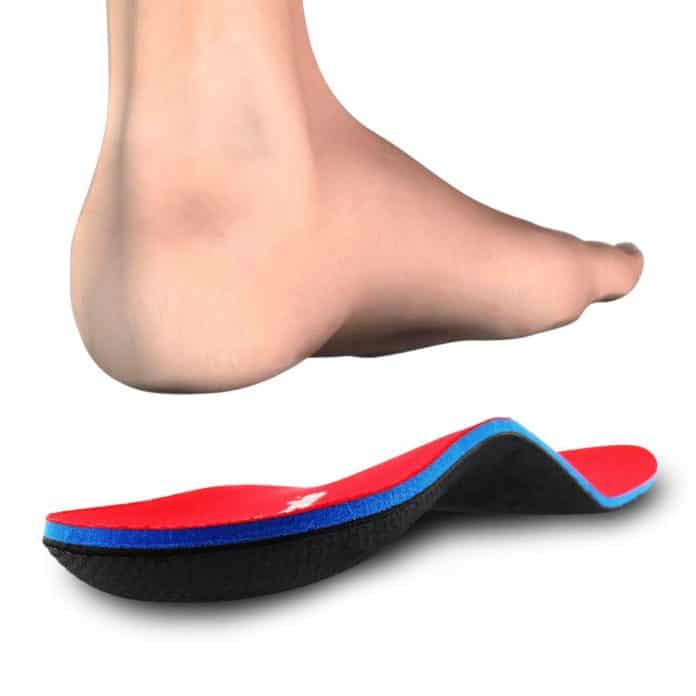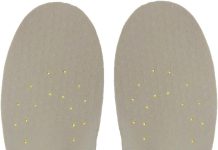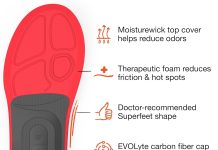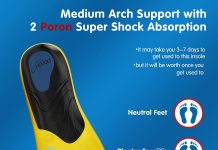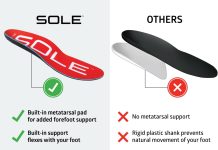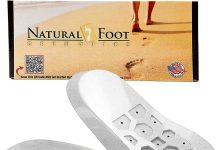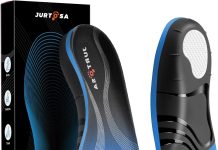Have you ever wondered how insoles provide arch support? Well, wonder no more! In this article, we will explore the fascinating world of insoles and delve into how they work to support your arches.
Whether you suffer from flat feet or want extra cushioning, understanding how these small inserts can make a big difference in your comfort and well-being is vital. So, let’s get started and unlock the secrets behind the wonders of insoles!
Materials used in insoles
Foam
Foam is commonly used in insoles due to its soft and cushioning properties. It provides a comfortable and supportive foundation for the foot by absorbing shock and pressure while walking or running. Foam insoles are lightweight and offer good stability, making them suitable for everyday use.
Gel
Gel insoles are another popular choice for arch support. They are made of a gel-like substance that molds to the shape of the foot, providing personalized support and cushioning. Gel insoles distribute pressure evenly across the foot, reducing the strain on the arch and relieving discomfort.
Memory foam
Memory foam insoles are designed to contour to the foot’s shape, offering customized arch support. They are responsive and adaptive, adapting to the individual’s foot structure and providing excellent shock absorption. Memory foam insoles also help relieve pressure points, making them ideal for individuals with sensitive or problem-prone feet.
EVA
Ethylene-vinyl acetate (EVA) is a lightweight and flexible material commonly used in athletic insoles. It offers good shock absorption and cushioning, reducing the impact on the arch and the risk of injuries. EVA insoles also provide stability and support, making them suitable for high-impact activities.
Polyurethane
Polyurethane insoles are known for their durability and long-lasting support. They provide excellent shock absorption and cushioning, reducing the strain on the arch and preventing foot fatigue. Polyurethane insoles are often used in work boots and shoes, as they can withstand heavy use and provide reliable arch support throughout the day.
Supportive fabrics
Some insoles utilize supportive fabrics, such as nylon or polyester, to enhance the structural integrity and stability of the arch support. These fabrics help distribute pressure evenly across the foot, reducing the strain on the arch and preventing overpronation or supination.
Arch reinforcements
Arch reinforcements are inserts or structures added to insoles to provide targeted support to the arch area. These reinforcements may be made of materials like plastic or carbon fiber, and they help shape and maintain the arch’s natural curve. Arch reinforcements are particularly beneficial for individuals with flat feet or high arches, as they promote proper foot alignment and prevent excessive strain on the arch.
Understanding the arch of the foot
Types of arches
The foot’s arch is the curved structure along the bottom of the foot that helps distribute body weight and provide balance and support. There are three main types of arches:
- High arches: High arches, also known as pes cavus, are characterized by a noticeably raised arch. Individuals with high arches may experience excessive pressure on the ball and heel of the foot, leading to foot pain and instability.
- Normal arches: Normal arches, also known as neutral arches, have a moderate curve that evenly distributes weight across the foot. People with normal arches typically have a balanced gait and are less prone to arch-related problems.
- Flat arches: Flat arches, also known as fallen arches or pes planus, have a minimal or no arch. This condition can cause the foot to roll inward excessively (overpronation), leading to foot pain, instability, and an increased risk of injuries.
Functions of the arch
The arch of the foot plays several essential functions:
- Shock absorption: The arch acts as a natural shock absorber, cushioning the impact of each step and reducing the strain on the joints and muscles of the foot and lower leg.
- Weight distribution: The arch helps distribute body weight evenly across the foot, preventing excessive pressure on specific areas and minimizing the risk of pain or injury.
- Balance and stability: The arch provides stability and balance, allowing us to stand, walk, and run efficiently.
Common arch-related problems
Several arch-related problems can arise due to imbalances or abnormalities in the arch structure:
- Plantar fasciitis is a common condition characterized by inflammation of the plantar fascia, a band of tissue that runs along the bottom of the foot. It often causes heel pain and arch discomfort.
- Arch strain: Excessive strain on the arch can result in pain, fatigue, and discomfort. Overpronation and excessive pressure on the arch can lead to arch strain.
- Flat feet: Flat feet occur when the arch collapses or is incorrectly formed. It can cause pain, instability, and an increased risk of foot-related problems.
- High arches: High arches can lead to a lack of shock absorption and increased pressure on the ball and heel of the foot, potentially causing pain and instability.
Importance of arch support
Arch support is crucial for maintaining proper foot alignment, preventing arch-related problems, and promoting overall foot health. When the arch is supported correctly, the foot can function optimally, reducing the risk of injuries and discomfort. Arch support also helps distribute weight evenly across the foot, preventing excessive pressure on specific areas and promoting a balanced gait.
Anatomy of insoles
Arch support structure
The arch support structure is a critical component of insoles designed to provide arch support. It consists of a raised or contoured area that mimics the natural curve of the arch. The arch support structure helps maintain the foot’s proper alignment, preventing excessive pronation or supination and promoting optimal foot mechanics.
Cushioning layer
The cushioning layer of insoles is responsible for absorbing shock and providing comfort while walking or engaging in activities. This layer is usually made of foam or gel materials and helps reduce the impact on the arch, minimizing the risk of injuries and enhancing overall foot comfort.
Heel cup
The heel cup is the part of the insole that cradles and supports the heel. It helps stabilize the foot and prevent excessive movement or pronation. A well-designed heel cup provides proper alignment for the entire foot, supporting the arch and reducing the risk of arch-related problems.
Metatarsal pad
Some insoles are designed with a metatarsal pad, a raised area near the football. The metatarsal pad helps alleviate pressure on the metatarsal heads and supports the foot’s transverse arch. This feature is particularly beneficial for individuals with high arches or forefoot pain.
Top cover
The top cover of the insoles is the layer that comes into direct contact with the foot. It is usually made of a soft, breathable material designed to enhance comfort and prevent friction or irritation. The top cover also helps maintain proper hygiene and moisture control inside the shoe.
Benefits of insoles with arch support
Improved foot stability
Insoles with proper arch support significantly improve foot stability by promoting correct foot alignment and preventing excessive pronation or supination. They help distribute weight evenly across the foot, reducing the risk of instability and falls. Improved foot stability also enhances overall balance and posture.
Reduced risk of injuries
Arch support insoles help reduce the risk of common foot injuries such as plantar fasciitis, arch strain, and metatarsalgia. Proper alignment, stability, and cushioning allow these insoles to absorb shock effectively and minimize excessive pressure on the arch and other vulnerable foot areas.
Enhanced shock absorption
The cushioning properties of insoles with arch support enhance shock absorption, reducing the impact on the arch and other parts of the foot. This is particularly important during high-impact activities like running, jumping, or walking on hard surfaces. By absorbing and distributing shock, these insoles protect the arch from excessive strain and minimize discomfort.
Alleviation of arch-related pain
Individuals suffering from arch-related pain, such as plantar fasciitis or flat feet, can find relief with insoles that provide proper arch support. The structured arch support helps reduce pain and discomfort by promoting optimal foot alignment and cushioning the arch.
Promotion of proper foot alignment
Insoles with arch support promote proper foot alignment, preventing excessive pronation or supination. Correct foot alignment ensures that the joints, muscles, and ligaments of the foot function optimally and reduce the risk of overuse injuries. These insoles supporting the arch improve overall foot biomechanics and help maintain a balanced gait.
How insoles provide arch support
Even weight distribution
One of the primary ways insoles provide arch support is by distributing weight evenly across the foot. By creating a supportive and contoured surface, insoles help prevent excessive pressure on specific foot areas, including the arch. This even weight distribution reduces strain and promotes a balanced and natural gait.
Compression and support
Insoles with arch support are designed to compress and support the arch, preventing it from collapsing or overpronating. The compression helps maintain the arch’s natural curve, providing stability and reducing the risk of arch-related problems. This support helps align the foot correctly and improves overall foot function.
Alignment correction
Many insoles are designed to correct foot alignment issues by providing targeted support to the arch. Through a combination of arch structure and customization, these insoles help align the foot in its optimal position. This alignment correction reduces strain on the arch and ensures that the foot functions as intended.
Shock absorption
Insoles with arch support incorporate cushioning materials to absorb and dissipate shock. When walking or engaging in activities, these insoles absorb the impact forces that would otherwise strain the arch excessively. The shock absorption properties of these insoles reduce the risk of injuries and minimize discomfort.
Improved foot biomechanics
Arch support insoles promote improved foot biomechanics by encouraging correct foot alignment, reducing excessive pronation or supination, and supporting the arch. By optimizing foot biomechanics, these insoles improve movement efficiency, reduce foot and lower leg stress, and enhance overall foot function.
Choosing the right insoles for arch support
Determining arch type
Before selecting insoles for arch support, it is essential to determine your foot’s arch type. You can do this by examining the shape of your footprint on a piece of paper after stepping out of the shower. You likely have a standard or neutral arch if your footprint shows a complete arch. If only a thin band connects the heel and ball of the foot, you may have high arches. Finally, you likely have flat feet if most of your footprint is visible, showing minimal or no arch.
Consideration of foot conditions
It is also essential to consider any existing foot conditions or problems when choosing insoles for arch support. Individuals with plantar fasciitis or metatarsalgia may benefit from additional cushioning and support in the arch area. Those with flat feet may require more rigid and structured arch support, while individuals with high arches may benefit from more cushioning and shock absorption.
Custom vs. off-the-shelf insoles
When selecting insoles for arch support, you can choose custom-made or off-the-shelf insoles. Custom-made insoles are specifically designed to match the contours and needs of your feet, offering a personalized fit and support. On the other hand, off-the-shelf insoles are pre-designed and come in various sizes and arch heights. Both options can provide adequate arch support, but custom-made insoles may be more suitable for individuals with specific foot conditions or irregular arches.
Professional recommendations
If you are unsure about which insoles to choose, it is recommended to consult with a foot healthcare professional, such as a podiatrist or orthopedic specialist. These professionals can assess your arch type, foot conditions, and specific needs and provide personalized recommendations for insoles that best support your feet. Their expertise and guidance can ensure that you select the right insoles and experience the maximum benefits of arch support.
Impact of arch support on different activities
Running
Arch support is particularly crucial for runners due to the repetitive impact forces and high-stress levels placed on the feet during running. Insoles with proper arch support help absorb shock, reduce strain on the arch, and promote optimal foot alignment, reducing the risk of injuries such as plantar fasciitis and stress fractures. Runners with high arches or flat feet can benefit significantly from the stability and cushioning provided by arch support insoles.
Walking
For everyday walking, arch support insoles can provide added comfort and stability. These insoles alleviate discomfort and fatigue by reducing strain on the arch and providing cushioning, allowing for longer and more enjoyable walks. They promote proper foot alignment, minimizing the risk of overuse injuries and enhancing overall foot health.
Sports
Sports such as basketball, tennis, and soccer involve quick direction changes, jumping, and high-impact movements. Insoles with arch support are essential for athletes participating in these sports, as they help absorb shock, stabilize the foot, and prevent excessive movement or pronation. Arch support insoles can enhance performance, reduce the risk of injuries, and provide additional comfort during demanding sports activities.
Occupational activities
Individuals who spend long hours on their feet in occupations such as nursing, retail, or construction can benefit from arch support insoles. These insoles provide added comfort, reduce foot fatigue, and help maintain proper foot alignment throughout the day. By reducing strain on the arch, these insoles can alleviate discomfort and prevent arch-related problems associated with prolonged standing or walking.
Different types of insoles for arch support
Full-length insoles
Full-length insoles, also known as shoe inserts, cover the entire shoe length and provide support and cushioning for the entire foot, including the arch. These insoles are suitable for all-day use, offering comprehensive support and stability.
Three-quarter length insoles
Three-quarter insoles cover the heel, arch, and forefoot areas, freeing the toes. They provide targeted support to the arch and are particularly beneficial for individuals who require additional arch support but prefer some flexibility in the toe area.
Arch support inserts
Arch support inserts are removable insoles explicitly designed to support the arch. They can be placed on top of existing insoles or the shoe’s footbed. These inserts provide customizable arch support and can be adjusted or replaced.
Orthotic insoles
Orthotic insoles are medical-grade devices prescribed by healthcare professionals to address specific foot conditions or alignment issues. These insoles are custom-made to fit the individual’s feet and provide optimal arch support, cushioning, and correction. Orthotic insoles are typically more expensive than off-the-shelf options but offer tailored support and maximum benefits for those with severe arch-related problems.
Custom-made insoles
Custom-made insoles are individually designed to fit an individual’s foot’s unique shape and arch type. These insoles are typically made by taking a mold or scan of the foot and crafting a customized insole based on specific measurements. Custom-made insoles offer the highest level of personalization and support, making them ideal for individuals with irregular arches, foot conditions, or unique biomechanical needs.
Combining insoles with other supportive footwear
Proper shoe fitting
It is essential to ensure proper shoe fitting when using insoles for arch support. The shoe should have enough room to accommodate the additional volume of the insole without causing discomfort or compromising the fit. Too tight-shoes can restrict foot movement and reduce the effectiveness of the arch support provided by the insole.
Importance of supportive footwear
Insoles for arch support are most effective when combined with supportive footwear. Shoes with proper arch support and cushioning enhance the benefits of the insoles and provide overall foot comfort and stability. It is advisable to choose shoes that offer sufficient arch support, a cushioned midsole, and a supportive heel counter to complement the arch support insoles effectively.
Orthopedic shoes
Orthopedic shoes are designed to address foot conditions and provide maximum support and comfort. These shoes often have built-in arch support and are compatible with arch support insoles. Orthopedic shoes can provide comprehensive support and allow for proper alignment and foot function when used with insoles for arch support.
Sport-specific shoes
Different sports require different types of footwear to cater to specific movement patterns and demands. Sport-specific shoes, such as running shoes, basketball shoes, or hiking boots, are designed with specific features to enhance performance and reduce the risk of injuries in those activities. These sport-specific shoes can use Insoles with arch support, further enhancing foot stability, shock absorption, and overall performance.
Overcoming challenges with insoles
Initial discomfort
Some individuals may experience initial discomfort or an adjustment period when using insoles with arch support. This is typically due to the feet adapting to the new support and alignment provided by the insoles. Wearing the insoles for short periods and gradually increasing the duration can help the feet adjust comfortably.
Adjustment period
It is essential to allow an adjustment period when using insoles with arch support, significantly if the insoles modify foot alignment or provide additional support. The feet may need time to adapt to the new arch support and the changes in foot mechanics. Gradually increasing the duration and intensity of use can help the feet adjust more smoothly.
Maintenance and care
Proper maintenance and care are essential for maximizing the lifespan and effectiveness of insoles with arch support. Following the manufacturer’s instructions, regular cleaning can help prevent odors and maintain hygiene. Some insoles may also require periodic replacement, especially if they lose their shape or cushioning properties over time. Checking and replacing the insoles as needed ensures optimal arch support and foot comfort.
Replacing worn-out insoles
Over time, insoles can wear out and lose their cushioning and support properties. When the insoles no longer provide adequate arch support or cushioning, it is important to replace them to maintain foot health and prevent discomfort. Monitoring the condition of the insoles and replacing them as needed is crucial for experiencing the full benefits of arch support.
In conclusion, arch-support insoles offer numerous benefits for foot health and overall well-being. By providing proper alignment, cushioning, and shock absorption, these insoles alleviate arch-related pain, promote stability, reduce the risk of injuries, and enhance foot biomechanics.
Choosing the right insoles, understanding your arch type, and considering any existing foot conditions are essential factors in experiencing the maximum benefits of arch support. By combining insoles with supportive footwear, such as orthopedic or sport-specific shoes, individuals can optimize foot stability and performance.
Overcoming initial discomfort, allowing for an adjustment period, and maintaining the insoles properly can help achieve long-term foot comfort and support.
Whether for daily activities, sports, or occupational use, insoles with arch support can significantly support your feet and promote optimal foot health.
Plantar Fasciitis Feet Insoles Arch Supports Orthotics Inserts Relieve Flat Feet, High Arch, Foot Pain Mens 9-9 1/2 | Womens 11-11 1/2
Dr. Foot's 3/4 Length Orthotic Insoles, High Arch Support Inserts for Flat Feet Plantar Fasciitis Over-Pronation and Foot Pain (Medium (Men's 6.5-8.5 / Women's 7.5-9.5))
(NEW-220+lbs) Plantar Fasciitis High Arch Support Insoles Inserts Men Women - Orthotic Insoles High Arch for Arch Pain - Heavy Duty Support Pain Relief - Boot Work Shoe Insole (Gray, M)
DR. POTTER+ 3/4 Orthotic Insoles, Shoe Inserts for Plantar Fasciitis Relief, High Arch Support Inserts for Flat Feet, Over-Pronation and Heel Pain (Medium(Men's 6.5-8.5 / Women's 7.5-9.5))
$15.99 in stock
PCSsole High Arch Support Orthotic Insoles, Pain Relief Shoe Insert for Men and Women for Flat Feet, Plantar Fasciitis, Heel Pain, Feet Pain, Heel Spur Pain, Metatarsalgia, Over Pronation(28cm)
$28.49 in stock

